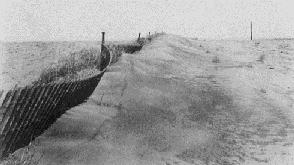THE GREAT DUST STORM (DUST STORM DISASTER)
(Woody Guthrie) (1930s)


Any copyrighted material on these pages is used in "fair use", for the purpose of study, review or critical analysis only, and will be removed at the request of copyright owner(s).




A national tendency existed to overemphasize the role of the dust-bowl area in the 1935-1940 migration. When Californians sought names other than "Okies" for the migrants, they called them "dustbowlers," and popular writers invariably began their accounts of the migration with a paragraph or two of overblown prose describing the dust storms.And, to be sure, the dust storms were dramatic. In April 1935, those who had sown the Plains soil with cotton and wheat and corn quite literally reaped the whirlwind of their wasteful and dangerous cultivation of marginal land. Overplowed, overworked, the topsoil lay in wait for prolonged drought. In the mid-1930s, the dry times came and the soil turned to dust. With the first winds, the dust rose and blew across the eastern half of the continent, some of it settling only when it reached the Atlantic Ocean. On many days during the great dust storms, the sky was black at midday; housewives removed half an inch of soil from their kitchen floors, and not even blankets stuffed beneath the doors and into the cracks around the windows prevented the inexorable advance of the dust. The storms were a menace to health and a dual catastrophe for agriculture. When the topsoil lifted, it destroyed millions of acres of marginal land; when it fell, it suffocated crops on well-tended acres.
Agronomists, and state and federal officialdom, recognized even in the dust storms a man-made catastrophe, the results of years of improper land use. The American people, including the migrants, found beneath these more rational explanations a kind of unconscious comfort in viewing the storms as a judgment from the Almighty. It was far more comforting, in a way, to be driven from the land by an "act of God" than to be harried off by an International Harvester. Throughout the 1930s, popular folklore persisted in so viewing the meaning of the dust storms. Woody Guthrie, himself an Okie and the most important American folk singer of his day, helped foster the popular conception of the dust storms as judgment in his "Dust Storm Disaster"....
Walter J. Stein, California and the Dust Bowl Migration, Westport, CT, 1974, pp. 13-14.


On the 14th day of April of 1935,
There struck the worst of dust storms that ever filled the sky.
You could see that dust storm comin', the cloud looked deathlike black,
And through our mighty nation, it left a dreadful track.From Oklahoma City to the Arizona line,
Dakota and Nebraska to the lazy Rio Grande,
It fell across our city like a curtain of black rolled down,
We thought it was our judgement, we thought it was our doom.The radio reported, we listened with alarm,
The wild and windy actions of this great mysterious storm;
From Albuquerque and Clovis, and all New Mexico,
They said it was the blackest that ever they had saw.From old Dodge City, Kansas, the dust had rung their knell,
And a few more comrades sleeping on top of old Boot Hill.
From Denver, Colorado, they said it blew so strong,
They thought that they could hold out, but they didn't know how long.Our relatives were huddled into their oil boom shacks,
And the children they was cryin' as it whistled through the cracks.
And the family it was crowded into their little room,
They thought the world had ended, and they thought it was their doom.The storm took place at sundown, it lasted through the night,
When we looked out next morning, we saw a terrible sight.
We saw outside our window where wheat fields they had grown
Was now a rippling ocean of dust the wind had blown.It covered up our fences, it covered up our barns,
It covered up our tractors in this wild and dusty storm.
We loaded our jalopies and piled our families in,
We rattled down that highway to never come back again.


